Secrets secrets are no fun! Secrets secrets hurt someone! That someone is you….
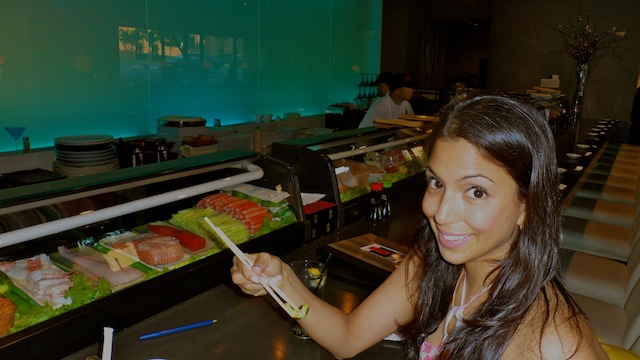
As you might have heard, the Japanese are one of the cultures that have the longest life expectancy. Many studies have been conducted to find out why this is true. All studies point in one direction. Their diet. Raising land animals isn’t very practical in Japan, so right off the bat they are protected from factory farming practices and meat/dairy products that are filled with harmful additives, antibiotics, and growth hormones. The Japanese rely mainly on very healthful staples such as sea vegetables, fresh fish, rice, buckwheat (soba) noodles, and fermented soy products such as miso.

I, too, want to realize the benefits of these healthful foods and live a long life! So naturally, one of my favorite foods to eat when I am not cooking is sushi! I only eat certain kinds of sushi and have it prepared as simply as possible. The typical “American” Japanese restaurant is destroying the basic Japanese ancient health tenants, westernizing your meal by adding all sorts of chemicals and additives. If you are eating sushi because you think it is healthy – Please look a little closer at what’s really lurking in your roll…
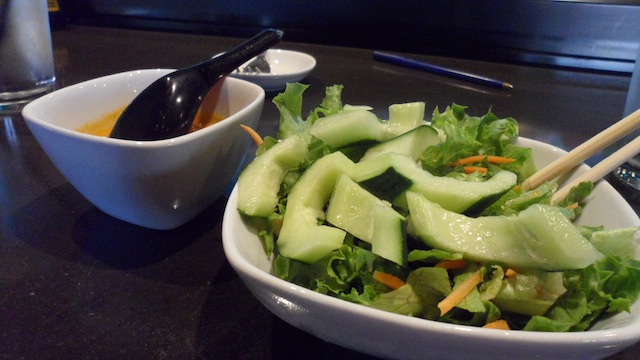

Speaking of rolls, rolls were not typical in Japan. Neither was eating sushi on a normal basis. Sushi is considered a special occasion food and is very expensive in Japan. Most sushi in Japan is served similarly to the picture below. This “nigiri” is prepared by the chef and the chef intends for you to eat it exactly like it is served, using your fingers. No, you don’t dip it in a huge bowl of sodium filled soy sauce.
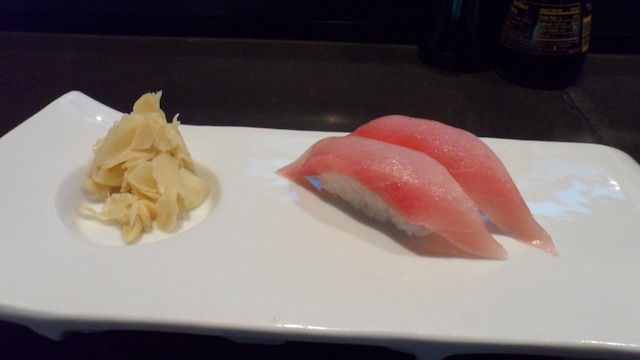
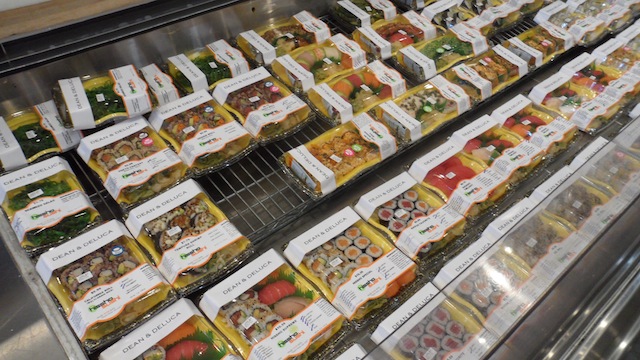
Rolls really are a western phenomenon that developed when sushi became more popular in other cultures outside of Japan. Most people who are just starting out with sushi are commonly recommended the “California Roll.” The reason westerners started with this roll, is because it was the most normal sounding. “Already cooked crab meat and avocado, that can’t be all that bad – sure I’ll try it.” California was the entrance for many Japanese chefs that started serving sushi in America. They needed a substitute for “Toro” fatty tuna and the oily and fatty nature of avocado worked perfectly. Also they hid the seaweed by making the roll inside out because Americans were not accustomed to the texture of seaweed “nori”.
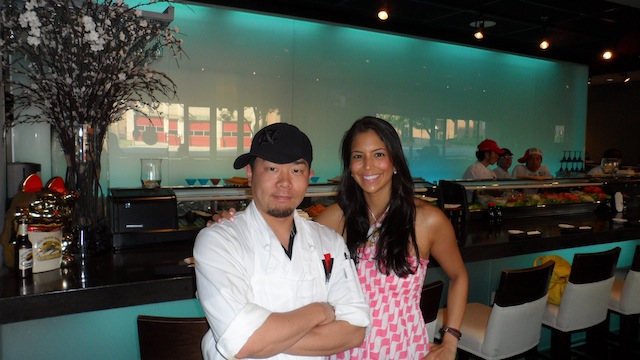
True Japanese chefs are artists and take the aesthetics and quality of ingredients seriously when preparing food, however, this has gone by the wayside in many sushi restaurants. The chefs have to use the ingredients the restaurant owners buy from food manufacturers… Food colorings, excitotoxins (MSG), harmful preservatives, and transfats are everywhere in those products. Let’s closely examine the favorite items from any typical sushi menu….
1. Don’t order the Seaweed Salad without asking about the ingredients – Food coloring is typically added to make that bright green color. Yellow #5 is linked to hyperactivity and allergic reactions. Blue #1 has caused brain cancer in lab animals.
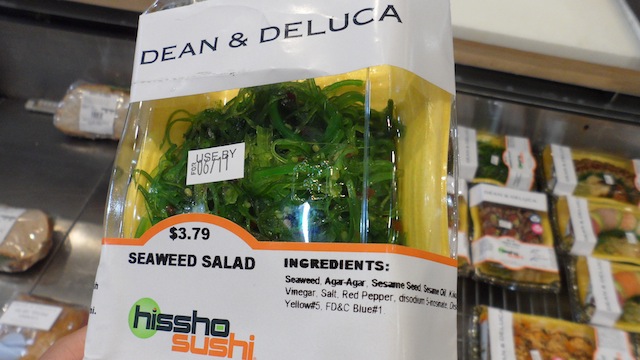
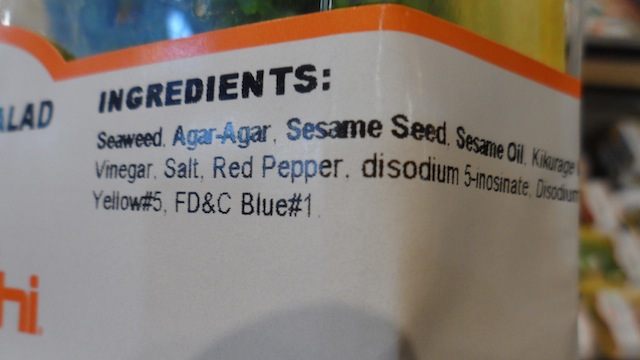
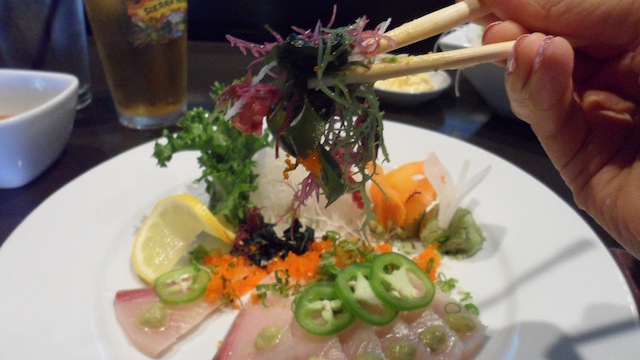
2. Ordering Edamame – Beware of non-organic varieties, as they are full of pesticides and have been genetically modified. Skip it if the restaurant can’t tell you it’s organic. 3. Forget Fish Roe (Tokibo) – These tiny little fish eggs are cultivated and then dyed beautiful colors to help you feast with your eyes! Look but don’t touch!
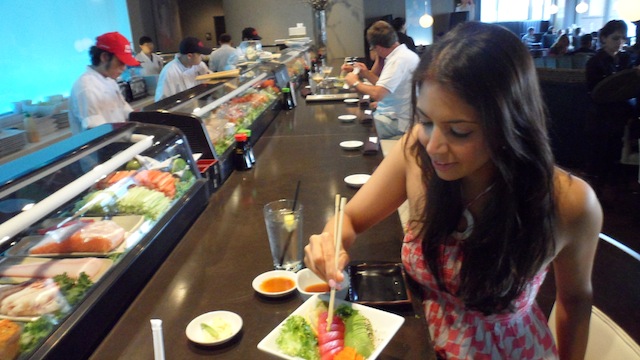
4. Eliminate Imitation Crab – This the typical “fish” found in the California roll and many other rolls. This stick of processed crap is really comprised of minced fish meat from several different fishes left over in some factory somewhere, dosed with fillers of egg whites, gluten, artificial colors, sorbitol, and a bunch of other ingredients like hydrolyzed soy protein and disodium inosinate – forms of MSG, which are excitotoxins that are horrible chemicals that wreak havoc on the human bodies and make you eat more than you should. See a picture of all the ingredients in typical imitation crab below.
5. Freak out on Farmed Salmon – I would say the majority of sushi restaurants serve farmed salmon. This stuff is dreadful – the poor fish are fed lots of corn, antibiotics, food coloring pellets to make them turn bright pink and left to grow in toxic pools with high levels of chemical pesticides. The main reason why salmon is healthy for you is because of the Omega 3 fatty acids, how is a farmed fish eating corn going to provide any of those nutrients to you? Did you know farmed salmon has about 50 extra calories per 3 ounce serving than wild salmon and contains half as much of the available Omega 3? Just choose other types of fish – here’s a great guide to sustainable and safe fish that my friends at EDF shared with me. They partnered with Monterey Bay Aquarium to create it. There’s also a Seafood Watch App available on the iTunes store as well as Android Market for free! Although I don’t go there often because it’s too far from my house – New Zealand Café is one of the places that serves wild salmon sushi.
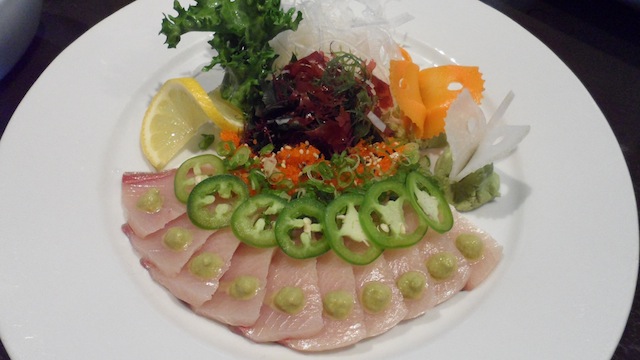
6. Limit your dip – One tbsp of soy sauce has roughly 500 mg of sodium…. Those little bowls are easy to fill up and if you fill it up to the top, it can contain over 2500 mg of sodium! That is a ridiculous amount of sodium to be consuming at one meal. Wonder why your skin is all puffy or why your stomach is bloated? I personally don’t even use soy sauce anymore, I use a small amount of “ponzu” sauce that I ask the Japanese chef for. It’s a little sweeter than soy sauce because it contains some mirin (Japanese cooking wine), but has about half the salt of even the low sodium version of soy sauce. 7. Dairy doesn’t belong in Japanese cuisine! – Cream cheese? Spicy Tuna made with mayo? – These probably contain non-organic dairy and if you were paying attention from above, the typical Japanese diet doesn’t contain any dairy. This is another example of how westernizing sushi has turned its health value upside down. If you really can’t live without the garlic mayo – try asking the chef to include it on the side – a little can really go a long way! 8. What’s up with the fake Wasabi? – Real Japanese horseradish is amazing for you! It’s got a wonderful anti-carcinogenic effect for your body. Meaning, it can fight all sorts of toxins and pollutants your body can get exposed to over time and prevent many forms of cancers. Wasabi is also anti-microbial, which is important because it helps prevent forms of raw fish bacteria from harming your body. Now for the sad part, most sushi restaurants are using a cheap alternative they can get in bulk in the form of powder. This powder, unfortunately, contains harmful additives like food coloring (Yellow and Blue make Green!). High quality restaurants will have the real deal, but you have to ask. Ask quietly and nicely and they might share with you!
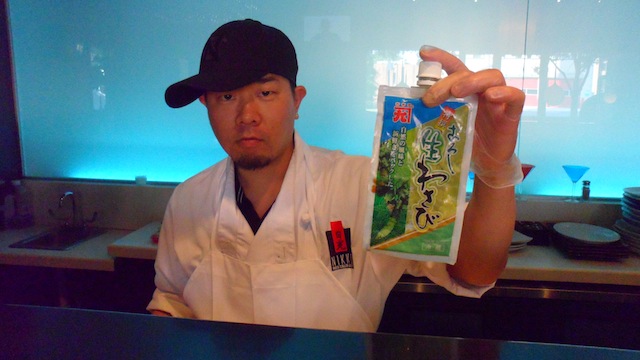
9. Recognize your Rice – Sushi rice is typically short grain rice that is polished white, cooked and then mixed with rice wine vinegar. When you add vinegar to the rice, this decreases its glycemic index, thus reducing the surge in blood sugar you normally would have if you ate rice alone. Ah ha! This is how the Japanese get away with eating white rice! Ancient Japanese secret unveiled! But does that mean you go crazy with the rice? No…. This is what I do instead. Since I prefer to have lower quality carbs as dessert, I order my vegetable roll sans rice and add asparagus – Check it out – this is so “delicious and refreshing” ….I’m quoting a business partner I recently went to lunch with…. He loved it and said “I don’t even miss the rice!” Also there is the option of ordering brown rice at some places, this is a nice substitute if available.
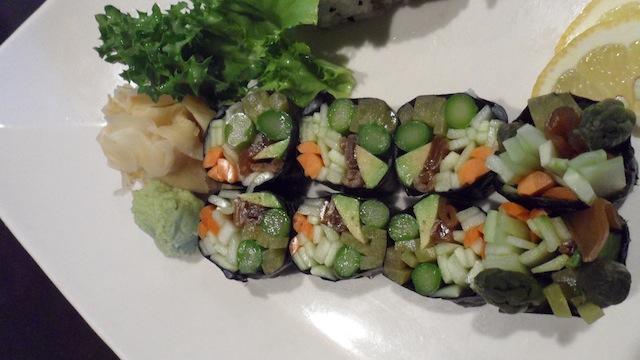

10. Don’t be tempted by Tempura – Think twice about ordering any roll, menu item or dessert that is fried or has the word “tempura” in its description. What kind of oil are they using to fry? This is huge. Do they fry it in transfat? Corn or soy oil? Or the traditional seasme oil, which would be the best alternative – find out! Ask them before you order!
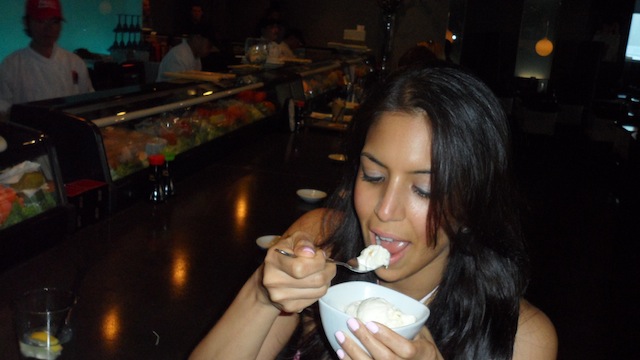
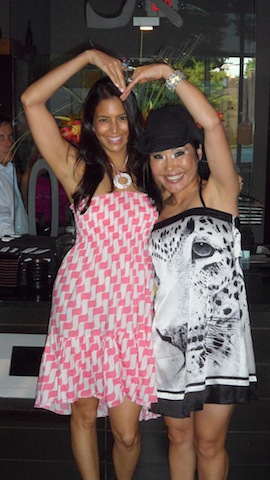


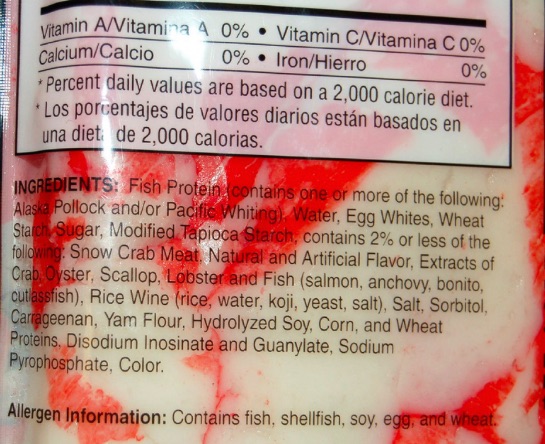



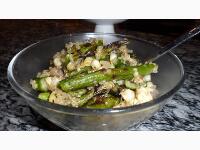


This is excellent Vani. Can’t wait to try out my new sushi tips. What about the ginger? Its almost my favorite part but I don’t know if its real at some places. Also..is the miso soup worth getting at the restaurants or is it packed with sodium?
Great questions! Wow – More sushi secrets to unveil! The ginger is pickled so it naturally turns that pinkish color, so don’t be scared of added dyes. However, if the sushi restaurant doesn’t make it in house and supplies it from a big food manufacturer, watch out. There is probably some preservatives and potentially fake sugars like aspartame.
As far as the miso soup – I’d be careful. If you are concerned about the sodium for any reason, I’d suggest starting with the salad I mention in my post to be safe. I think it would be ok to have miso soup, if you didn’t have any additional sodium for the rest of your meal, but I find that to be an unlikely scenario for most people. Also always ask if it contains MSG before consuming!
Truely awesome article..you have researched well and explained everything that needs to be known. Vani, you should have been a journalist!!!
love
Whew. I was scared I’d have to give up the ginger. I eat it straight with my chopsticks! I’ve gotta tell you… I’ve been craving sushi ever since I read this article.
all of the pickled ginger I’ve ever seen includes food dyes 🙁
I have to interject here….
The ginger is that color because they pickle it with the leaves (sometimes Shiso leaves) that impart a pinkish color…. other ginger is a light brown color, and that is a more natural coloring for ginger.
Actually sushi ginger is dyed but naturally with adding a purple shiso leaf to the vinegar. Non dyed ginger is flesh colored.
Sharing with all my friends here!
Thanks Rubena! What’s your favorite sushi spot in Hot-lanta?
girl! you are way too cute…love your well-documented eating tour of nyc! so many healthy, natural, interesting places and dishes. sounds like you lived it up. 🙂
Thanks Mary! I have such a great time every time I go to NYC. I get so many ideas that we need to implement here in the south! I am hoping we get more options for raw and vegan restaurants.
Have you tried raw food restaurant “Pure Food & Wine” in NYC. Amazing
Thank you for all of this wonderful information! Especially the Onigiri sandwiches!
So..I just recently learned of your blog and am loving it! It is right up my alley with the way I live my life and what I believe in regarding health in mind, body and soul and how we can achieve balance and happiness by making good decisions about what we do to and put in our bodies. I consider myself “vegish” because I eat a lot of raw and vegan food, but also eat fish. After reading your blog on “Sushi Secrets”, I asked my favorite fish market (Clean Catch off Selwyn) how they prepare their seaweed salad. And guess their response…First, they don’t make it themselves–it comes from a distributor in Hawaii (which I was okay with) until I asked more specifically if they could tell me the ingredients that the distributor uses, particularly asking about Yellow 5 and Blue 1 explaining your research found on these chemicals in food. Quite concerned, they openly showed me the ingredient list they had on hand and sure enough the last 2 listed were Yellow 5 and Blue 1! As did I from your blog, they admittedly said they learned something new and immediately vowed to make changes to their seaweed salad! So my very Vani influenced moment at the fish market may have possibly lead to a good change! Especially important for a market that is so committed and prides themselves on the freshest fish in Charlotte! I was so glad for the positive reaction and thanks to your research and inspirational blog, we all may get to enjoy some “real” seaweed salad!
Just posted this on my Facebook Page – thank you for taking the time to leave such a thoughtful comment. I really hope Clean Catch “cleans” up the seaweed. I haven’t seen seaweed available that doesn’t have crappy ingredients in quite sometime… wonder where they will source it from.
Good Luck Katie!
Vani
What sushi dishes do you recommend for someone squeamish to the raw fish?
Honestly – I don’t eat much raw fish these days. There is a lot of quality and safety issues I am concerned about. Try the veggie rolls – I just love them…but if you really wanted to try the fish – try a something with avocado and cucumber. Good Luck!
I am surprised that in your article you didn’t mentioned about high mercury level in tuna fish.
So glad I found your blog! Fabulous and informative posts – I’m sharing with everyone! I especially love the “Food Babe Investigates” posts, they are awesome and we really appreciate your hard work that goes into all the research! Off to find wild salmon now in Boston 🙂
I find your website interesting, however you need to improve your writing skills and proofread your work. Don’t depend on spellcheck, and practice using better grammar to make your writing appear more professional, as well as more readable. At present, it is quite amateurish.
@Molly – I am almost positive I remember hearing her say that English isn’t her first language. She communicates an incredible wealth of wisdom and very critical information; the last thing I am going to do is pick on grammar (and I have been known to play the roll of “Grammar Police” in my various Communications/Creative Director positions).
Wow Molly, way to totally miss the point lol. This is a blog, not a publication.
Isn’t it funny that Pretentious Molly’s first sentence is riddled with entirely incorrect punctuation? Google the use of “however”. You’re missing a semicolon and a comma.
…which is exactly why we all need to get off our respective high horses. No one is an absolute expert; no one is perfect.
I love Sushi.. however in US its really difficult to find a place where you get good REAL sushi.. I miss my HongKong days. Also, I am pregnant right now and advised against eating Sushi.. eagerly waiting for the curfew to end 😛
Make sure you also avoid anything that contains high fructose corn syrup (if you don’t already). HFCS isn’t FDA-regulated, and independent tests have revealed dangerously large amounts of mercury in it, far more than the amount found in a few servings of, say, salmon. Mercury has been linked to fetal damage, including retardation and missing limbs. Isn’t it funny, though, that most doctors villianize fish (which can be very helpful during pregnancy, in moderation), but never tell women to avoid the typical American diet that is inundated with HFCS?
I am also pregnant but I have eaten a lot of sushi with this pregnancy and had it when pregnant with my daughter as well. I researched and avoided tuna due to the mercury, but felt the benefits of the omegas outweighed the small risks of eating raw fish. I stick to places I know and trust. I try to eat wild salmon, but after reading this I will be far more vigilant! I also didn’t know HFCS had mercury, although I try to avoid it anyway.
Thanks for a great article, I learned some new things to watch out for!
A HFCS study found that 48% of the drums tested had Hg levels significantly higher than what is considered to be “non-detrimental” by the FDA (p<.01). Essentially theres a 50-50 chance of consuming pathologically high levels of Hg when eating products with HFCS. I'd say you have the right idea. Wild, organic, non-GMO fish over HFCS-filled bread all the way! (Note: I mentioned GMO fish, because scientists in Japan have developed a transgenic line of salmon that grow larger in a shorter amount of time. It hasn't been approved for sale yet, but with the political power of various food companies, it may only be a matter of time.)
Thank you for writing this. I NEVER thought about sushi because I just assumed it was “healthy”. I am learning so much from your site. What about Thai food?
My local supermarket has a delish sushi stand in their food court. My 7-year-old daughter and I always sit down and eat some edamame and seaweed salad (in addition to the rolls) before shopping. I pride myself on raising her on the best foods and educating her on how to make healthy choices for herself. I will now be reconsidering our selection. But I have to admit, it is so discouraging and even overwhelming that even the best health foods have gone to ….
On a lighter note, I just got introduced to your blog a few days ago through Food, Inc.’s Facebook post and have been obessed ever since! You really are an inspiration! 🙂 Thank you
What about the mercury content of the fish, especially the tuna?
http://www.americanpregnancy.org/pregnancyhealth/sushimercury.htm
Also do not eat white tuna it is also called escolar and will give you the runs…….
Salmon is not a traditional sushi fish…. the typically use salt water fish versus freshwater due to the chance of worms…….
Curious about your comment about Tuna not being a traditional sushi?!? In Fish markets in Japan, the Blue Fin tuna is one of the most prized and most expensive fish (up to and over a million dollars) and is currently close to being completely wiped out as a species (although the Japanese are experimenting with trying to “farm raise” these).
They also eat dolphin and whale sushi. The Hump in Los Angeles (now closed due to undercover sting) served Sei (endangered whale).
Excellent info, thanks so much!
Love, love, love your posts, thank you SO much!
Love Nikko.
I thought brown rice has higher levels of arsenic?
I am wondering what your thoughts are about Whole Foods Farmed Salmon? I always purchase our salmon from there. Is it safe?
I’m not an aquaculture expert, but based on some (minimal) research my understanding is that your best bet is wild Alaskan salmon. Aside from various ecological issues, farm raised fish tends to be less “clean”. Like chickens confined to crowded cages, the fish are treated with antibiotics to prevent the spread of disease, and therefore the decrease of the “farmer’s” profit margin. There is some evidence that suggests that any sort of cage-raised animal can be 30% or more less nutritious than its free range or wild counterpart. A really nice option is to get Alaskan salmon directly from the source. If you know any anglers, you can go to Alaska and rent a boat to take you out fishing. My dad does this at least once a year, and brings back about 100lbs of wild Alaskan salmon and halibut each time. It’s the freshest and most delicious fish I’ve ever eaten.
Kristin – you are so lucky! That sounds amazing… My husband brings home Elk from his trips which is great too but I would rather have salmon and halibut!
Sandra & Kristin – wild is always a better choice because it contains more nutrients and like Kristin said the conditions in salmon farms are usually poor. Whole Foods has very strict standards on their sources so their farmed comes from clean farms. Still, I always choose wild if possible – I think it tastes so much better anyway. Hope that helps!
i love the nigiri from whole foods made with brown rice and salmon. i love that they will make it fresh for me so i know it’s fresh
I used to LOVE sushi. I mean, once I tried 10 different sushi restaurants in one week to find out the best sushi. However, I don’t eat sushi any more. According to a Japanese nuclear scientist, Fukushima Daiichi nuclear disaster was much more serious than what is reported. It is 1000 times stronger than Hiroshima Nuclear bomb in the second world war, and even 100 times worse than the Chernobyl Nuclear Disaster. Japanese government is trying to cover it up and trying to make it illegal to measure and report radioactivity in Tokyo area.
So the fishes caught near Japan are practically all contaminated. That is why I stopped eating fish caught in Pacific Ocean especially fish from Japan. There are many reports that there are unusually large cabbages and eggplants are grown and an ear-less bunny was born near Tokyo.
So be careful with Japanese food.
tenets*
hey great article… just wanted to let you know mayo is not a dairy… while it is not vegan, the only ingredients in mayo are egg yolk, oil, and, vinegar (also lemon juice and salt to taste). Just thought I’d let ya know!!!
One correction –
Sushi is not as special as one would think. Although sashimi is considered a delicacy and special meal, sushi was Japanese’s original fast food. Many Japanese enjoy sushi being served on a conveyor belt and will handle it with their hands. It is a very informal experience and allows the Japanese “salary man [and woman]” a quick bite during a lunch break. 🙂
Hey there,
I love the large majority of what you put out there. You’re great at raising awareness on little known but pervasive nutritional topics and you’re truly making a difference. The above article is excellent as well but, one point you make early on was a bit inaccurate…
You mention that “The typical Japanese diet contains little to no land animal products.” – this is untrue. In most parts of Japan the diet is quite varied by region – things like yakitori and ramen are very meat focused and much of the food you’ll find at izakayas in Japan includes meat. Dairy, however, is not common so you’re right on that front.
Another thing to consider, however, is that food quality standards are so high in Japan that it’s not uncommon to see something like chicken skewers served so lightly seared it’s almost raw and for people to be totally alright with that.(It’s very rare someone becomes ill) I would imagine these food quality standards extend to animal feed, restriction on the use of hormones, etc… as well – making consumption of animal products/meats that much safer.
Regardless, this was an informative article for those of us who love sushi – me included – but it’s definitely not the staple diet of most Japanese.
Thanks for really knockin’ out of the park with post after post… still love ya – keep ’em comin’ 😉
-Alex
Is that true that we should avoid all kinds of atlantic salmons, even wild?
Yes Andrea – that is correct.
http://www.slowfood.com/slowfish/pagine/eng/pagina.lasso?-id_pg=88
Thank you! 🙂
Food Babe, Thanks for the article. Very hard to digest the truth because I love sushi (like the americanized one). I was wondering, what about liquid aminos as a substitute for soy sauce? Thanks!
Coconut aminos are great – check them out.
Thanks so much for this! Would you consider doing a post on Vietnamese Pho in the future?
Thanks!
Sarah
Thanks for this wake-up call on sushi as we eat it all the time. I started having the chef make special handrolls with assorted fish 3 years ago when I found out I was allergic to wheat, corn and soy. No more soy sauce and ginger. Its been great. I do have a question – you brought up about tobiko (masago) – what about salmon roe? Is it a natural color or is it also dye? What about eel? Thanks again for an informative article…
Good comments. But unfortunately that sushi restaurant in the picture looks extremely expensive, which isn’t practical for a lot of sushi eaters.
But keep up the good work.
I was just noticing (while eating sushi from my local grocery store) that the 2nd ingredient in the Tobiko is High Fructose Corn Syrup. Another surprise (although I don’t eat the stuff) is that there is Aspartame in the Picked Ginger. I immediately remembered your post on Sushi and re-read it. I love how much you care for others and want us all to be educated in the ingredients in our food. It is my passion as well. Needless to say, this sushi I have before me (with the exception of the Nigiri) is going to waste.
Where do I get good seaweed salad then? I eat that even if I don’t eat sushi. Ohhh…. everything I love is bad for me :'(
“The typical “American” Japanese restaurant is destroying the basic Japanese ancient health tenants… ”
tenant – a person who rents a space to live or work in
tenet – main principles of a religion or philosophy
informative post, but always proofread.
Who needs to proofread when we have amateur “editors” such as yourself and Molly McGuire? You are receiving free information provided by someone’s in-depth and time consuming research. While there might be someone out there who appreciates your two cents (and the two seconds it took you to give it) certainly the articles and information provided by the author are more useful to the majority of readers.
we are still importing food and fish from japan by hillory clintons approval,rubber and bromine in our bread is one thing but RADIATION is unacceptable!! utube video just came out by a profesional about this subject.food babe please watch this video and warn the world about this cotastrophy.its in the water on the west coast and its been blowing this way in the air for a couple of years now.your onna roll now please dont stop!! link to video
http://www.youtube.com/watch?v=en_CiEnJ4Wo
is RA sushi good?
My son is sensitive to Yellow #5 food coloring. We recently had sushi and he had a one of his typical Yellow #5 reactions. He ate only Cucumber Maki rolls. I stumbled upon your blog because I searched for food coloring in seaweed. Everything I’ve found indicates that seaweed SALAD often contains food coloring. Do you have any idea if just the actual seaweed used to make the Maki might also contain food coloring? I’m trying to figure out where his reaction came from. Thanks for any info you can provide.
I had the same question as Sylvie!
I Miss Food Babe, I’m a sushi lover and wanted to know if you can recommend me a healthy Sushi in or near Eagle Rock, Ca.?
Hey Food Babe, wow so many secrets concerning sushi. this article blew my mind. I had to have a hazmat team clean it up.This was very informational. although i really hate sushi, i still found this to be interesting. The part about the salmon really peaked my interest. I love salmon. I had some previous knowledge about farm fed being bad, but i didn’t know it in detail. but i am still concerned about the mercury content in the natural salmon. so i guess companies should just make healthier (white/clear) salmon.
sincerely
Amrik, the Brave
Try Bragg’s liquid amino as an alternative to soy sauce. Zero sodium, tastes the same (if not better!), and it has natural amino acids -which are actually GOOD for you!
http://bragg.com/products/bragg-liquid-aminos-soy-alternative.html
Evanna, Bragg’s product has a similar amount of sodium to reduced-sodium soy sauce (far from zero), and amino acids are found naturally in almost all foods, including soy sauce.
Sesame oil is not a safe alternative for deep-frying, as it is still high in omega-6 and oxidizes quickly with high heat.
Hi!
I just got some sushi from harris teeter for lunch and after eating it I saw the ingredients FD&C Yellow 5 in the wasabi! I was like WTH. So I googled “Foodbabe wasabi” and came upon this article :). I love the HT sushi, but I’m gonna have to ask them if they have the real deal wasabi.
Thanks for all your work and research.
Also, I would love to know where in Charlotte you get your no rice sushi that you’ve shown in your picture. Looks YUMMM!!
lady, I’m glad you’re so rich! You’re also an alarmist using outdated information at times. It’s also not realistic to feed the world on organic which is over hyped. No one’s claiming artificial stuff is great for you, but it is sometimes necessary. I wouldn’t be able to eat or you want to find sushi in a hundred miles if I followed your stupid suggestions. Get real. This is Earth, not heaven.
While it takes effort to eliminate artificial ingredients from your diet, it is possible here “on Earth”. Food Babe is spoon feeding us the way to go about it. You don’t have to be “rich” to eat clean (junk food is a lot more expensive than fresh food) If it’s too difficult, it’s just not a priority.